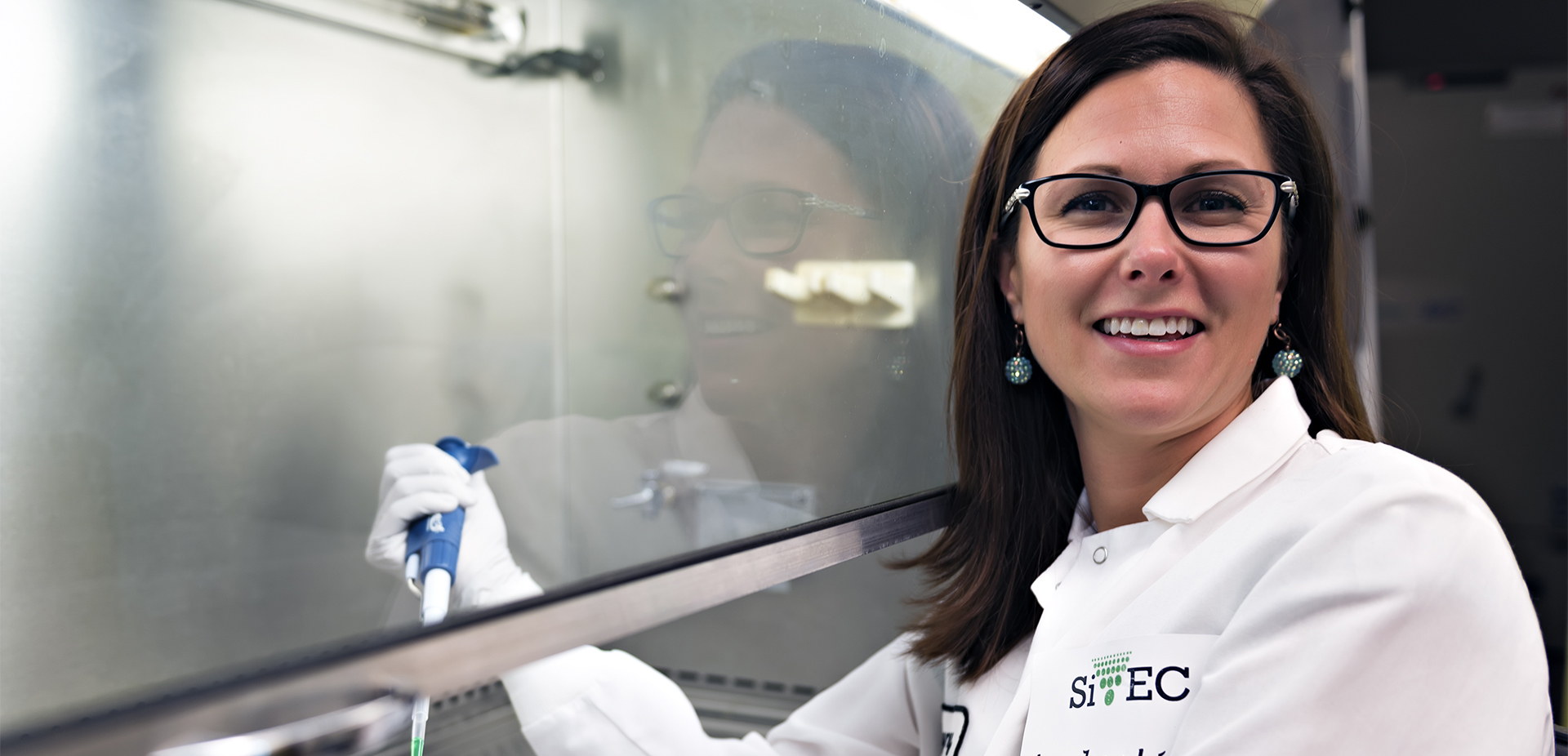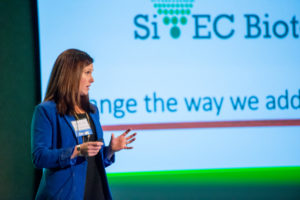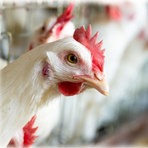
The day after Lyndsey Linke won the 2016 Colorado State University’s Collegiate Challenge business pitch competition, she boarded a plane for North Carolina to compete in the U.S. Masters Swimming national championship.
Her competitive spirit and drive have been fueled over the years through swimming. She now brings that same intensity to the table as the founder of SiVEC Biotechnologies.
Linke, a postdoctoral research scientist in the Department of Clinical Sciences, filed documents to incorporate SiVEC Biotechnologies in April, just two weeks before the startup competition. Her product? A new antiviral technology, SiVEC-AIV™, to prevent the spread of avian flu virus in poultry.
Avian flu is a huge issue for commercial farmers and government agencies. In 2015, following an outbreak in the U.S., economists estimated the cost of the lost birds and industry revenue losses to be $3.3 billion. More than 48 million birds had to be killed, and the U.S. Department of Agriculture also spent $500 million to stop the disease outbreak.
On a global scale, nearly one-third of the world has been affected by avian flu outbreaks, and the estimated revenue loss is $40 billion and rising.
Linke has developed a technology that inhibits the flu virus from replicating, and can be used before flocks are infected. Her novel idea? An aerosol delivery system that allows the antiviral to be applied quickly, on a broad scale. It offers 90 percent protection and is inexpensive. All those things add up to SiVEC having an impact.

“From the very beginning, the idea wasn’t just that I would develop something. This has the potential to change the industry, not just in the United States but globally,” Linke said.
Startup idea hatched during graduate school
Linke didn’t start out intending to save the world’s poultry. She was pursuing a master’s degree in engineering at CSU when she learned about something called RNA interference. RNA is a molecule that plays a central role in the function of genes — the “business” end of a genome.
“You can make small interfering RNA nucleotides, or siRNAs,” Linke explained. “You can design them so they match up with a gene in the virus. When the siRNAs come in contact with the viral gene, the two will essentially bind together, and this binding acts like a signal to chew up and destroy the viral gene. In very simple terms, this technique prevents the virus from replicating.”
A self-described science nerd, Linke said she thought RNA interference was “the coolest thing since sliced bread. I wanted to find a way to work that into whatever I did as a career.”
After she received her master’s in 2005, she landed a job with CSU’s Animal Population Health Institute lab, which conducts research on economically important infectious diseases in animals. Linke saw the opportunity to marry the topics of RNA interference and avian flu in poultry.

“Avian flu in poultry was a very sexy topic at the time,” she said. “There were highly pathogenic avian flu outbreaks happening in Asia, and there was a lot of funding available to prevent the virus. The idea came to me: I’m going to find a way to use these small RNAs to inhibit avian flu in poultry. That became my Ph.D. dissertation.”
Not your average grad student
Jeff Wilusz, an RNA molecular biologist and professor in the Department of Microbiology, Immunology, and Pathology, said Linke wasn’t your average graduate student.
“Lyndsey was very much a self-starter,” he said. “Many graduate students are bright, do research projects and stay within the ballpark you give them. Lyndsey very clearly stepped outside of the playing field. It wasn’t one of those things on the side. She was persistent.”
Wilusz provided Linke with the knowledge and expertise to construct the antiviral, she said.
“Jeff had lectured on RNA interference in one of my early Ph.D. graduate courses, before I started my dissertation project and when the concept was only an idea,” Linke said. “I instantly knew I needed to talk with him and eventually asked him to be a member of my graduate committee to help guide my research.”
Looking back, Wilusz said her pursuit of this project was “crazy talk” for a student in that position. At the time, he thought, “If she could pull it off, she could do something special.”
And pull it off, she has.
Research proves antiviral works
Linke continued pursing her Ph.D. while working full-time at CSU as a research associate. She published papers showing proof of concept for the technology, presented her research at international conferences, and applied for grants to help fund her research. “I would get so tantalizingly close to getting funded,” she said, reflecting on the early challenges.
What she needed at that point, however, was to show how the antiviral technology could be effective in live animals. Linke found a company based in Cambridge, Mass., that had created a way for bacteria to target mucosal tissues — the type of tissue that lines the passages of your nose, throat, lungs and other parts of the body. She was fairly confident that this type of system could serve as a delivery vehicle for the small RNAs or siRNA nucleotides she created.

To test the technology, the antiviral is given to chickens through their nostrils. Twenty-four hours later, the birds are infected with avian flu. Linke then measures the amount of virus that is replicating in each chicken, and how much virus is being shed. (Sneezing is how humans shed virus.) She also studies what happens with a control group of chickens not infected with avian flu.
In the long-term, SiVEC-AIV will be misted into the air, and chickens will breathe it in.
The bar is set pretty high to demonstrate the effectiveness of poultry vaccines and alternative technologies like SiVEC-AIV. “To achieve clinical efficacy, you must demonstrate at least a 100-fold reduction in the virus,” Linke said. Results from numerous tests showed a 400-fold reduction.
“To look at a data set and realize that it worked, it was pretty phenomenal,” she said.
Moving quickly
Now, everything is “brand new” and “moving very quickly,” Linke said. In addition to $20,000 in startup capital, winning CSU’s Collegiate Challenge allowed SiVEC Biotechnologies to become one of four online finalists for the Capital Championship, a nationwide startup tournament, and compete against 9 other teams for a $250,000 top prize. While Linke did not win it all, she received valuable feedback and had many opportunities to network.
Beyond the contests, Linke sees the big picture of this novel technology she’s created. “As a researcher, the impact of what I’ve developed is a big deal,” she said.
Others agree. Steve Foster, director of licensing and business development at CSU Ventures, met Linke in January 2013 at a research day event sponsored by the College of Veterinary Medicine and Biomedical Sciences, and found her concept for treating avian flu interesting.
CSU Ventures filed a provisional patent application for the technology that same month and continued to work with Linke through the Ambassadors program, which prepares scientists to become entrepreneurs. In January 2015, CSU Ventures filed a full patent application for SiVEC Biotechnologies.
“Lyndsey is very driven but very humble,” Foster said. “She’s a very strategic thinker.”
“It feels amazing to get this initial validation for what I’m doing,” Linke said, reflecting back on the last few months. “There have been a lot of obstacles in the last six or seven years of developing this technology.”
And while she’s not yet free of all challenges, the victories she’s had of late reinforce the value of her hard work and help guide her toward the finish line.
“I am okay with taking a risk,” she said. “Nothing ventured, nothing gained. I have to jump in. It’s scary but the rewards can be huge.”
Lyndsey Linke is a postdoctoral research scientist at Colorado State University in the Department of Clinical Sciences in the College of Veterinary Medicine and Biomedical Sciences. Her work focuses on combining infectious disease epidemiology/preventative medicine, biomedical engineering and microbiology to develop population-based antivirals and diagnostic assays for viral and bacterial diseases.